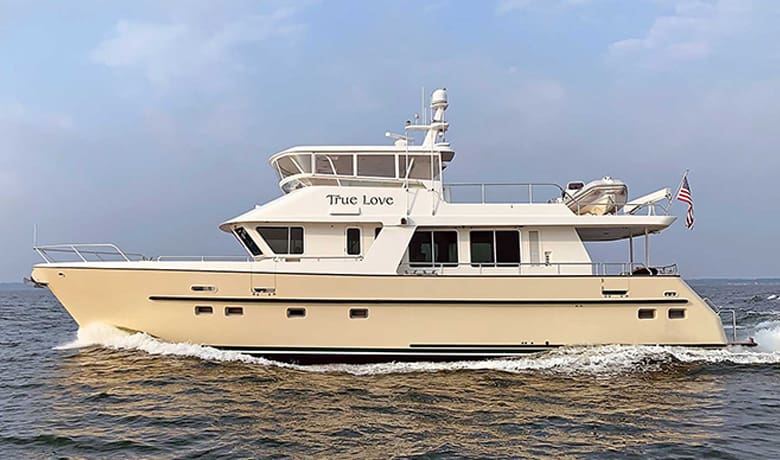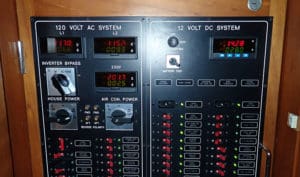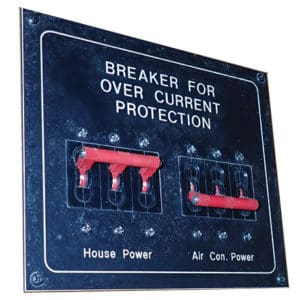

“Jeff, you would be proud of me. I was alone onboard and lost power in the middle of the night. The first thing I thought of was that maybe the onboard shore power breaker tripped. I grabbed a flashlight and looked where you showed me the breaker was located. It was a simple fix to cycle the breaker and restore power, thank you!” (Cindy C. – Selene 53).
All of the comforts of home are expected features aboard trawlers. The underlying source that allows us to indulge as if we were ashore is the magic of electricity. You probably don’t think about where electricity comes from at home, you just turn things on when you need them and they automatically work. Boats are wired differently than houses; you have to connect the flow of electricity through a breaker before it will provide power to any component.

Lights, outlets, navigation and communication displays, entertainment and galley appliances are just a few ship categories that require electricity. I’m not a “sparky,” but I’ve learned enough of the basics to be safe and respectful around electricity and try to offer simple explanations to my clients so that they understand the basics. “Power tripping,” (losing shore power), is something you should expect and be prepared to correct. It should be relatively easy to trouble shoot if you know how the links are connected in your trawler’s chain of electricity.
Every trawler is different, but in general the arrangement is something like this: A bank of batteries is wired to an inverter (some inverters also serve as battery chargers). The inverter takes DC (direct current) from the batteries and turns it into AC (alternating current). The inverter is connected to your ship’s electrical panel which is divided into different sections of AC and DC breakers.
When you are tied up in a marina with your shore power cord connected, your inverter is receiving electricity from the dock shore power pedestal.
Your ship’s electrical breaker panel should have a primary rotary select switch that enables you to choose where the panel is receiving power from – typically shore power or generator. If you have forward and aft shore power connections, they will each have a separate setting on the rotary select switch.
The key indicator to monitor on your electrical panel is the input gauge that shows AC voltage coming in (typically 120 volts from the dock). Know where this gauge is, learn how to read it and check it frequently. If your input gauge on the panel is registering zero, your power has been disrupted and you need to determine what has caused the interruption.
Let’s review a scenario where you are safely secured to the dock and connected via a shore power cord. Tracing your electrical flow is as easy as connecting the dots. The dock shore power pedestal has a breaker to provide or cut off power. You attach your shore power cord to the pedestal and to your deck fitting. The deck connection should be routed through a breaker (designed to trip if there is an overload) and from the breaker continue to your inverter and then to your ship’s electrical panel rotary select switch. The input gauge on your electrical panel will confirm that shore power is connected if you have everything set up correctly.
If your input panel gauge is not showing shore power coming in, you need to retrace each connection in the sequence to re-establish power. The most likely culprit is a disconnect involving your shore power cord. There are a couple of quick things to investigate. First, confirm on the dock pedestal that the power breaker is ON (cycle ON/OFF) and your cord is firmly connected. If you share a pedestal with a slip neighbor, it’s always possible that they inadvertently cut you off when they plugged in. While you are at the shore pedestal, twist and push the active end of your shore cord to confirm it is properly seated. Get back aboard to confirm the other end of the cord is secured to your on-deck connection. Then check the input gauge on the electrical panel to hopefully read that your shore cord has provided a path for electricity to come aboard.
If your input panel gauge is not registering, the next most common source of interruption is your on-board shore power breaker. By regulations, shore power breakers are required to be installed within close proximity to the shore power connection on deck. Unfortunately, these shore power breakers are often installed out of view and in locations that aren’t obvious. If your onboard shore power breaker has tripped, cycle it (OFF/ON) and then go check your power status on the electrical panel input gauge. The last thing to check, while you are looking at your ship’s electrical panel is the rotary select switch. If you are plugged in at the bow, it should be set for FWD Shore Power (some trawler designs have forward and aft shore power connections). Slowly turn the rotary switch to OFF and then back to the correct shore power setting.
An occasional power surge is not uncommon and should be an easy fix. Check the dock pedestal, both ends of your shore power cord, the on-board shore power breaker and the electrical panel rotary switch. Your electrical panel input gauge will tell you the story. Next time your boat goes on a power trip, you know what to do to get it back on line. n
Jeff Merrill, CPYB, is the president of Jeff Merrill Yacht Sales, Inc.- www.JMYS.com. He is a veteran yacht broker who specializes in trawlers. Merrill is active in the cruising community as a public speaker and writer and enjoys spending time at sea with clients. He is an online instructor for Boaters University and has a successful YouTube channel that includes a variety of relevant cruising videos. Jeff has written more than two dozen articles for Ocean Navigator’s Power Voyaging column and is constantly looking for new ideas and tips to share that simplify cruising and improve the trawler lifestyle. Jeff@JMYS.com.
